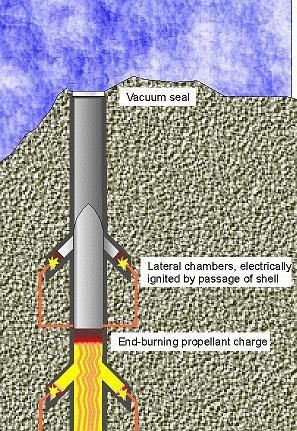
Home - Search - Browse - Alphabetic Index: 0- 1- 2- 3- 4- 5- 6- 7- 8- 9
A- B- C- D- E- F- G- H- I- J- K- L- M- N- O- P- Q- R- S- T- U- V- W- X- Y- Z
Valier-Oberth Moon Gun
 Valier-Oberth Gun |
Status: Design 1926.
First, the projectile was designed to be of tungsten steel, practically solid, with a diameter of 1.2 m and a length of 7.2 m. Even using the latest gun propellants, a barrel length of 900 m would still be necessary. To eliminate the compression of air in the barrel during acceleration, it was proposed that the barrel itself be evacuated to a near-vacuum, with a metal seal at the top of the barrel. Residual air would provide enough pressure to blast this aside before the shell exited the gun. To minimize drag losses in getting through the atmosphere, it was proposed to put the mouth of the gun above most of the earth's atmosphere: it would be drilled into a high mountain of at least 4900 m altitude.
Further improvements were suggested by Willy Ley and Baron Guido von Pirquet of Vienna in 1928. He proposed that an even higher mountain of 6100 m be used. To achieve the necessary muzzle velocity, it would be necessary to construct the gun with angled lateral chambers. These would have additional propellant charges that would be set off electrically as the shell passed by. Finally, the shell would have a charge of end-burning propellant attached to its base. This would accelerate it in the barrel in rocket-like fashion. These design concepts would be put to military use in the V-3 Hochdruckpumpe cannon of World War II. Baron von Pirquet lived to the age of 90, dying in 1966 at Schloss Hirschstetten.
Family: Gun-launched, orbital launch vehicle. People: Valier. Country: Germany. Bibliography: 47.
1926 - . Launch Vehicle: Valier-Oberth Moon Gun.
- Valier-Oberth Moon Gun - .
Nation: Germany.
Related Persons: Oberth,
Valier.
In the 1920's members of the VfR (Society for Space Travel) amused themselves by redesigning Verne's moon gun. In 1926 rocket pioneers Max Valier and Hermann Oberth designed a gun that would rectify Verne's technical mistakes and be actually capable of firing a projectile to the moon.
1928 - . Launch Vehicle: Valier-Oberth Moon Gun.
- Von Pirquet Moon Gun - .
Nation: Germany.
Related Persons: Ley,
Oberth,
Valier.
Further improvements to the Valier-Oberth gun were suggested by Willy Ley and Baron Guido von Pirquet of Vienna. To achieve the necessary muzzle velocity, it would be necessary to construct the gun with angled lateral chambers. These design concepts would be put to military use in the V-3 Hochdruckpumpe cannon of World War II.
Back to top of page
Home - Search - Browse - Alphabetic Index: 0- 1- 2- 3- 4- 5- 6- 7- 8- 9
A- B- C- D- E- F- G- H- I- J- K- L- M- N- O- P- Q- R- S- T- U- V- W- X- Y- Z
© 1997-2019 Mark Wade - Contact
© / Conditions for Use